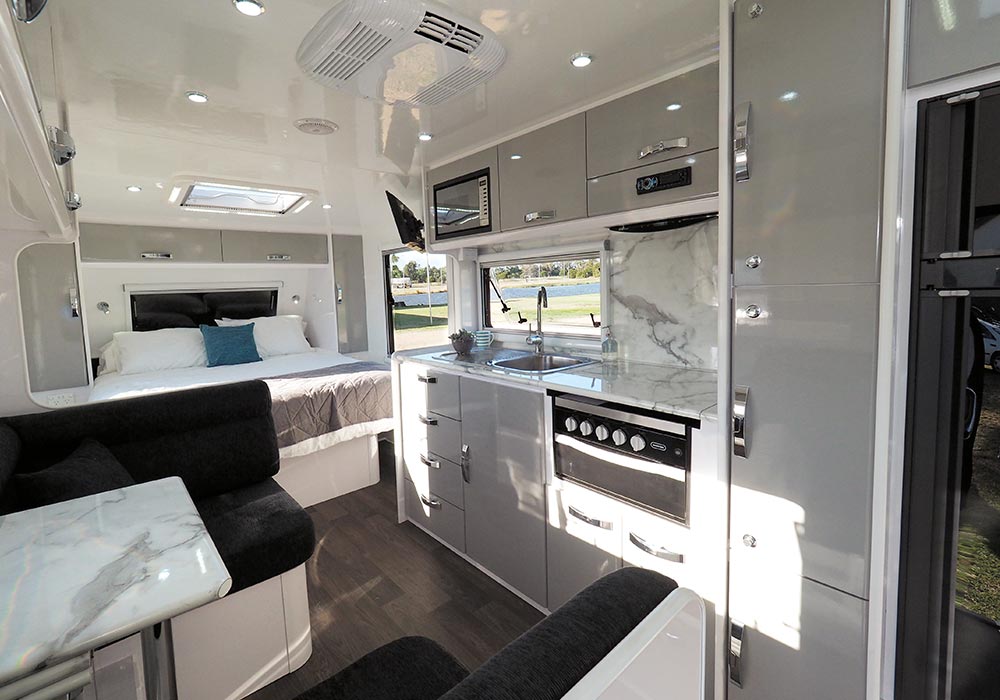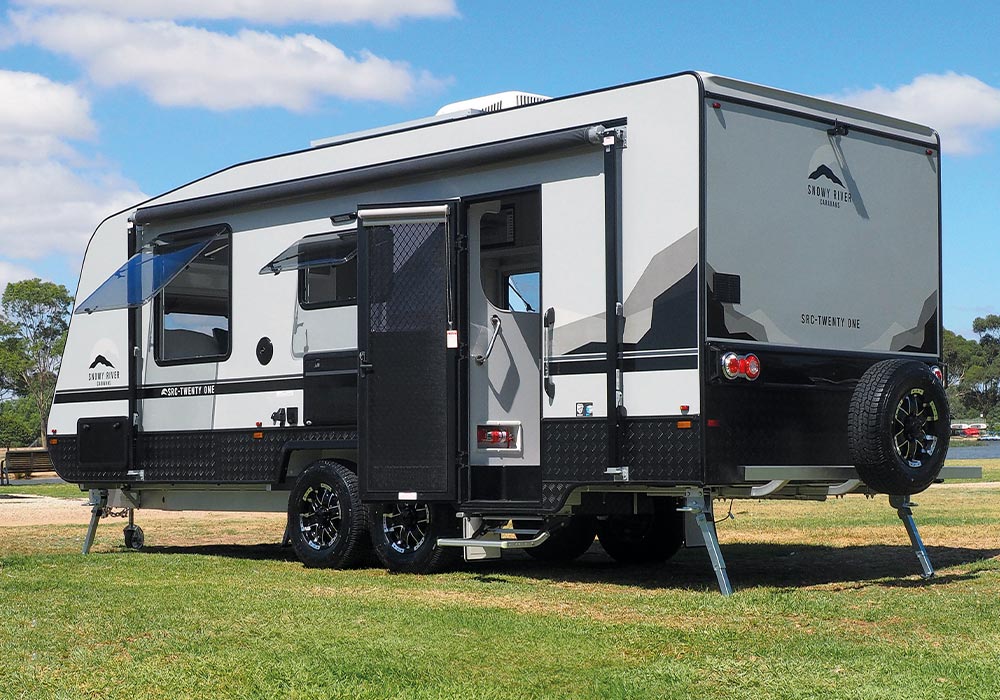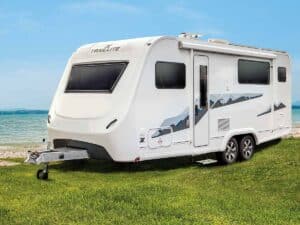There’s often a question about what makes an ideal external length for a van designed for couples. Snowy River Caravans’ SRC21 model may well provide the answer, says Malcolm Street.
Snowy River vans are built in China but the fitout and finish is done at the Australian company’s factory in Somerton, Victoria. Imported into New Zealand by Vanari Caravans, Snowy River offers a selection of vans ranging from 4200mm to 7000mm with both single and tandem axle configurations and include both family and slide-out layouts. The SRC21 fits in the middle. A while ago, Snowy River changed its van nomenclature, so the model number better reflects the external length. In imperial dimensions, that’s 21ft, or 6360mm. The external width is 2390mm, a little narrower than usual so the unfitted body fits into a shipping container.
Bodywork
A tandem axle caravan, the SRC21 has a tare mass of 2377kg and an ATM of 3000kg, giving a reasonable payload of 623kg. Fitted with independent torsion suspension and 15in alloy wheels, it has a semi-offroad rating with a normal ground clearance: essentially designed for sealed roads and well-graded rough road travel. Above the wheels, the DuraGal chassis has 100mm rails and a 150mm drawbar. The 95-litre water tanks are fitted on either side of the axles, and the 100-litre grey tank sits behind the rear freshwater tank. Two battery boxes are fitted to the front offside rail, resolving the issue of internal battery storage. At the rear of the van, the spare wheel is mounted on the bumper bar. It’s not mounted too high, making it relatively easy to get on and off.
Unlike many Australian-built caravans, the Snowy River SRC 21 has a timber-free construction using vacuum pressed fibreglass composite panels reinforced with box section welded aluminium framing and XPS foam insulation: 32mm for the roof and walls and 42mm for the one-piece floor. External storage capacity is excellent with both a front boot and a front tunnel storage. The two 9.0kg gas cylinders are mounted on the front drawbar rails. The living area has a Dometic awning, Aussie Traveller door, picnic table and external speakers. For power and TV, there’s a mains power socket, 12V socket and an antenna connection. Under awning living style is assured with a gas bayonet socket under the tunnel storage.
Step aboard
Over the past decade I have seen a few Chinese-built caravans and camper trailers where it was fairly obvious where the product came from. These days, standards have definitely improved, and it’s much harder to tell the difference from fully locally built products. Generally speaking, the fit and finish is pretty good.
The front bed-rear bathroom layout is well suited for a couple, with the kitchen bench along the offside and the dinette mid nearside. The glossy grey/white used for the walls and cabinetry and faux marble laminate for the bench tops is all easy on the eye, and large windows add to the generally light interior feel, not to mention giving a good cross flow of air.
Up front
Dominating the forward area is the 1900mm x 1500mm island bed. The side and front window areas are quite generous and the large foot hatch adds even more clear acrylic. Around the bed is the usual array of overhead lockers, side wardrobes and bedside cabinets. Each bed occupant gets a reading light and a double 230V power point with built in USB chargers. At the base of the bed, the walk around space on both sides is adequate.
Cooking time
Taking up most of the mid offside wall area, the kitchen is fully equipped with all the essentials like the Mobicool four burner (three gas, one electric) hob and grill, Dometic 174 litre three-way fridge and an NCE microwave. Alongside the hob is a stainless-steel sink and drainer. There isn’t a great deal of benchtop space but the hob does have a flush lid. There’s a generous amount of storage space – drawers, cupboards, overhead lockers – and a full height pantry. The drawer and door handles all lock securely and have extra push button locks fitted, but are easy to use, even for arthritic fingers.
Easy seats
Opposite the kitchen the design of the dinette has achieved the interesting feat of lounge-like seating that is still practical for dining. That’s achieved in part by the
multi-fold table that can be folded back when not utilised. Under the table you’ll find a small but useful cupboard, and below that are two 230V double power points which have the all-essential USB sockets and a 12V socket.
Staying clean
Many bathrooms have a standard look with all the essentials and this one is no different. Filling the rear nearside corner is a shower cubicle with room to turn around and a fan hatch in the roof. On the opposite side, the Dometic cassette toilet fits in between the bathroom wall and the corner cabinet with its top loading washing machine. The toilet passes the “elbow” test and the washing machine cabinet has a sliding top, making it easier to load a washing basket. Between the washing machine and shower is the vanity cabinet with double cupboard, pedestal wash basin and wall mirror. The bathroom isn’t oversized but there’s room to move.
Power system
Standard on the SRC21 is a 120AH AGM battery, 200W solar panel and a Projecta PM200 battery management system with a 30A charger. Since the fridge is a three way absorption model, that should allow for a number of days staying off grid. Like many vans, the real limiter is often the capacity of the toilet cassette. A roof mounted reverse cycle air conditioner will keep the van cooled or warm as required but for anyone contemplating winter touring, especially around the sub alpine areas, an optional diesel heater might be a consideration. A New Zealand automatic satellite and 24in Smart TV are standard fittings, and the van is fully set up for New Zealand plugs and sockets.
On the road
Having an ATM o 3,000kg puts the SRC21 firmly into the dual cab ute and above towing territory. Unladen, at 2,377kg, it’s a relatively lightweight van, but water tanks and loaded essentials will soon add up. That said, the van was well behaved behind my Mercedes Benz X Class ute tow vehicle. When reversing and parking, it was pretty easy to manoeuvre.
What else is included?
When a van is purchased, it’s ready to hit the road, after a familiarisation process. The New Zealand Pack consists of some items already mentioned, like the 100-litre grey water tank (not standard on the Australian models) and the Smart TV and automatic satellite dish, as well as all on-road costs (three-year WOF, one year rego), NZ electrical WOF, self-containment certificate and a start up kit, which consists of necessities like a heavy duty power lead, levelling ramps, jack and grey water hose and bag.
All Snowy River caravans have a five year structural warranty, two-year material and parts warranty on anything Snowy River manufacturers. Individual OEM manufacturer’s warranty will apply for components and appliances.
Summary
The SRC21 caravan ticks a few boxes in the construction and looks categories. Although not a particularly small van, it’s an easy towing prospect and offers plenty of caravan touring comforts, with all the essentials for contemporary travel.
| SPECIFICATIONS | |
|---|---|
| MAKE & MODEL: | Snowy River SRC21 |
| BERTHS: | 2 |
| AXLES/SUSPENSION: | Tandem/AL-KO™ Independent Rubber Suspension |
| LENGTH/WIDTH/HEIGHT: | 6360mm/2390mm/3070mm |
| FRESH/HOT/GREY WATER: | 2 x 95litre/100litre |
| LPG: | 2 x 9.0kg |
| TARE MASS: | 2,377kg |
| TOW BALL MASS (AT TARE) | 3,000kg |
| PRICE: | $91,500.00 |
For more information, visit https://vanaricaravans.co.nz/










